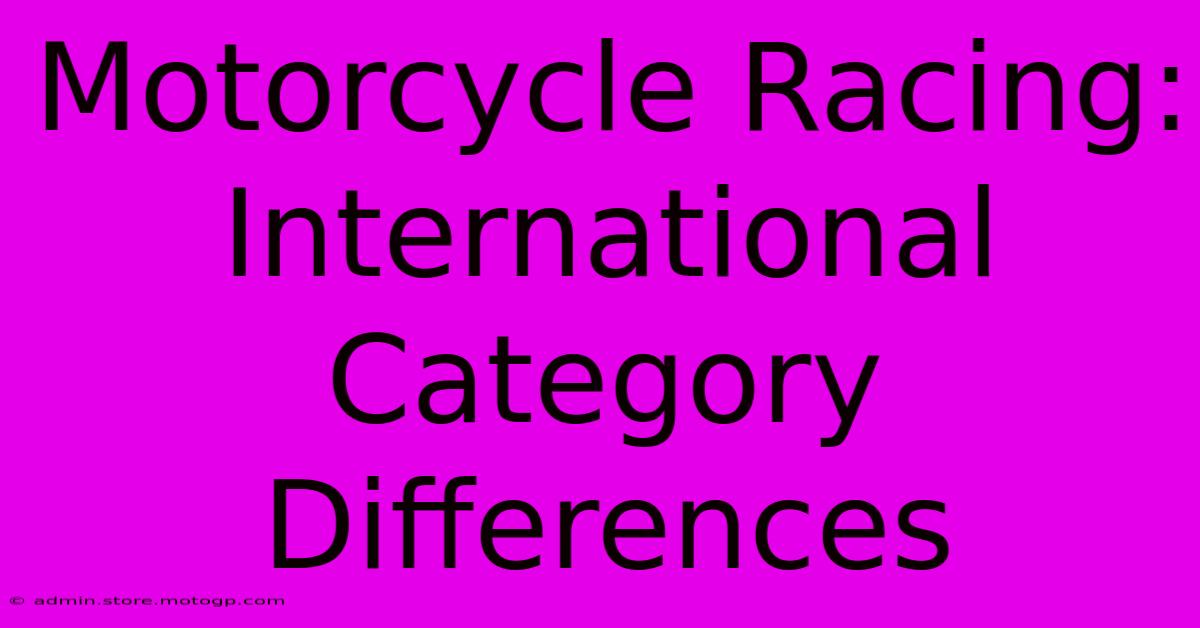Motorcycle Racing: International Category Differences

Table of Contents
Motorcycle Racing: International Category Differences
Motorcycle racing boasts a rich tapestry of international categories, each with its unique set of rules, machinery, and competitive spirit. Understanding these differences is key to appreciating the nuances of this thrilling sport. This article delves into the major international motorcycle racing categories, highlighting their key distinctions and what sets them apart.
The Apex: MotoGP
MotoGP, the pinnacle of motorcycle racing, features the most powerful and technologically advanced machines. These prototypes, boasting 1000cc engines, are the epitome of engineering excellence. Riders here are considered the best in the world, pushing the limits of speed and skill on the track. The competition is fierce, with top teams and manufacturers vying for championship glory. Key characteristics: Protoype motorcycles, 1000cc engine capacity, highest level of competition.
Key Differences within MotoGP:
While all MotoGP bikes are powerful, subtle differences exist in engine design and chassis setup. These small variations, often developed through years of research and development, can significantly impact performance on different track layouts. Manufacturers like Yamaha, Honda, Ducati, Suzuki (formerly), and Aprilia constantly battle for supremacy.
Stepping Stones: Moto2 and Moto3
Below MotoGP are two support classes that serve as vital breeding grounds for future MotoGP stars. These categories use standardized machinery, focusing the competition on rider skill and talent.
Moto2:
Moto2 utilizes a single engine supplier, ensuring a level playing field. The bikes, with 765cc engines, are powerful yet less complex than MotoGP machines. This allows for a closer competition and highlights rider skill above all else. Key characteristics: Spec engine (single supplier), 765cc engine capacity, focuses on rider skill.
Moto3:
Moto3 takes standardization a step further. These smaller, 250cc machines are designed to be more accessible and affordable, attracting a wider range of young riders. The lightweight and nimble bikes require incredible precision and control. Key characteristics: Small, lightweight machines, 250cc engine capacity, excellent entry-level category.
Beyond the Grand Prix: Other Notable International Categories
While MotoGP, Moto2, and Moto3 dominate the Grand Prix world, numerous other significant international categories exist, each with a specific focus and appeal:
- World Superbike Championship (WSBK): Features production-based motorcycles, showcasing the performance capabilities of commercially available machines. This provides a closer connection to the consumer market and makes the bikes more relatable.
- British Superbike Championship (BSB): A highly competitive national championship in the UK, often considered a stepping stone to World Superbike and even MotoGP. The level of competition is fierce, with many top riders competing.
- Superstock: This class sits between production-based bikes and full-on racing machines, often acting as a pathway to higher categories.
The Future of Motorcycle Racing Categories
The landscape of motorcycle racing is constantly evolving. Technological advancements, rule changes, and the pursuit of greater safety measures all contribute to ongoing adjustments within the different categories. This dynamic environment ensures that the sport remains exciting, competitive, and engaging for both racers and spectators.
Conclusion:
From the technologically advanced prototypes of MotoGP to the standardized machinery of Moto2 and Moto3, the world of international motorcycle racing offers a diverse and thrilling spectacle. Understanding the distinctions between these categories provides a deeper appreciation for the skill, dedication, and technological prowess required to succeed at the highest levels of this challenging and exhilarating sport. The future promises continued evolution and innovation, ensuring that the roar of the engines will continue to captivate audiences worldwide for years to come.

Thank you for visiting our website wich cover about Motorcycle Racing: International Category Differences. We hope the information provided has been useful to you. Feel free to contact us if you have any questions or need further assistance. See you next time and dont miss to bookmark.
Featured Posts
-
F1 Shuttle Service The Ultimate Race Day Upgrade
Feb 19, 2025
-
Moto Gp Commentators Shaping The Narrative
Feb 19, 2025
-
Us Gp Concerts The Ultimate Fan Experience
Feb 19, 2025
-
Your Ultimate Guide To Circuit Of The Americas Concert Schedule
Feb 19, 2025
-
Yamaha Moto Gp Racing Against All Odds
Feb 19, 2025
